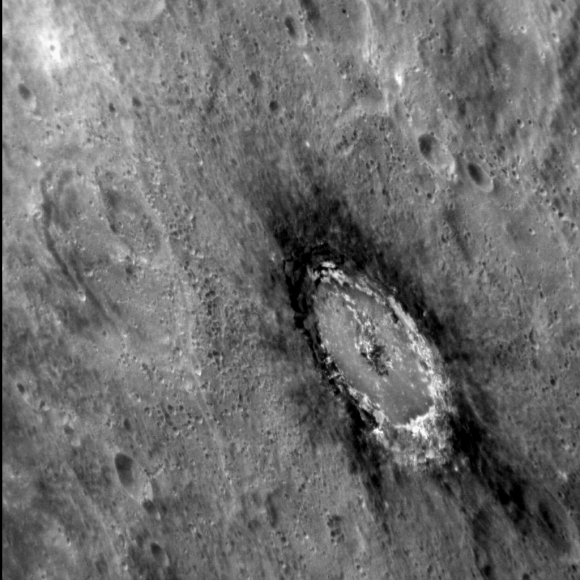Ever since the
MESSENGER
spacecraft entered orbit around Mercury in 2011, and indeed even since
Mariner 10
's flyby in 1974, peculiar "dark spots" observed on the planet's surface have intrigued scientists as to their composition and origin. Now, thanks to high-resolution spectral data acquired by MESSENGER during the last few months of its mission, researchers have confirmed that Mercury's dark spots contain a form of carbon called graphite, excavated from the planet's original, ancient crust.
Commonly found within and around impact craters and volcanic vents, the dark spots on
Mercury
—also referred to as "low-reflectance material," or LRM—were originally suspected to contain carbon delivered to the planet by comets.
Data from MESSENGER's Gamma-Ray and Neutron Spectrometer (
GRNS
) and X-ray instruments confirmed the LRM to contain high amounts of graphitic carbon, but likely originating from within Mercury itself. It's thought that Mercury was once covered by a crust composed of graphite, when much of the planet was still molten.
"Experiments and modeling show that as this magma ocean cooled and minerals began to crystallize, minerals that solidified would all sink with the exception of graphite, which would have been buoyant and would have accumulated as the original crust of Mercury," said Rachel Klima, co-author of a recent study on LRM and a planetary geologist at the Johns Hopkins University Applied Physics Laboratory. "We think that LRM may contain remnants of this primordial crust. If so, we may be observing the remains of Mercury's original, 4.6-billion-year-old surface."
[caption id="attachment_127750" align="aligncenter" width="580"]
Low-reflectance material surrounding an 80-km crater called Basho, imaged in May 2012[/caption]
See more MESSENGER images of LRM on Mercury here.
Although similar in visible coloration and covered in craters, cracks, and mountains, any similarities between Mercury and other smaller worlds in our Solar System—including our Moon—end there. Mercury has a formation history all it own and is compositionally unique among the planets.
These data revealing such a relatively high concentration of graphite in Mercury's crust only adds to those differences, and also tell us about the various elements that were present around the Sun when the planets were forming.
"The finding of abundant carbon on the surface suggests that we may be seeing remnants of Mercury's original ancient crust mixed into the volcanic rocks and impact ejecta that form the surface we see today," said Larry Nittler, research paper co-author and Deputy Principal Investigator of the MESSENGER mission. "This result is a testament to the phenomenal success of the MESSENGER mission and adds to a long list of ways the innermost planet differs from its planetary neighbors and provides additional clues to the origin and early evolution of the inner Solar System."
On Earth graphite is used in industry to make bricks that line refractory furnaces and increase the carbon content of steel. It's also widely used in fire retardants, batteries, and lubricants, and is mixed with clay in various amounts to create the "lead" in pencils (which, by the way, contain no actual lead.)
These
findings
have been published in the March 7, 2016 Advanced Online Publication of
Nature Geoscience
.
MESSENGER (MErcury Surface, Space ENvironment, GEochemistry, and Ranging) was a NASA-sponsored scientific investigation of the planet Mercury and the first space mission designed to orbit the planet closest to the Sun. The MESSENGER spacecraft launched on August 3, 2004, and entered orbit about Mercury on March 17, 2011 (March 18, 2011 UTC). On April 30, 2015, after four years in orbit MESSENGER's mission and operational life came to an end when it impacted the surface of Mercury
in its northern polar region.
Source: Carnegie Science and JHUAPL
Image credits: NASA/Johns Hopkins University Applied Physics Laboratory/Carnegie Institution of Washington
 Universe Today
Universe Today

